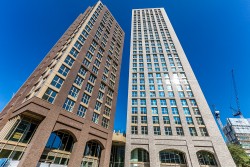The construction site has changed dramatically over the years, with safety, sustainability, efficiency, and legislation all driving factors that have led to product innovation and materials used, affecting how construction methods are approached. But now developers and contractors are looking at other means to make gains. Most notably the construction process and method itself.
Lewisham Exchange
One project that has benefited from offsite technology is the Lewisham Exchange development. Offsite construction methods were chosen due to the time saving properties and cost benefits provided. However, the development did not concede on design or aesthetics.
The Lewisham Exchange stands more than 100m at its highest point, making it the tallest modular student accommodation building in Europe. It is built from 3D volumetric structural steel modules, which were completed offsite by specialists Vison Modular. The innovative volumetric modules are manufactured using integrated structural steel framing with solid concrete floors built-in.
The twin-tower block structure consists of 35 and 20 storeys and accommodates more than 750 student apartments and around 70 affordable homes. Meanwhile its commercial properties at the foot of the structure achieved an 'Excellent' BREEAM rating, putting them in the top 10% of buildings from a performance perspective.
Structural Steel for Offsite Construction The use of 3D volumetric structural steel framed modules enabled on site construction to be streamlined and contributed to the impressive 35-week completion of the brick slip cladding installation by Century Facades Ltd, who also carried out the window installation offsite.
The build saw the housing 'mods' manufactured in optimal facility conditions, including windows, which were then delivered to site where they were erected around the building's lift cores. Then once ten or so storeys were complete, the external envelope's Mechslip brick cladding was constructed in unison – chasing the finished steel modules up the building. Offsite construction of the building's steel framed modules not only ensured time saving benefits compared to more traditional methods, but also quality of product with each one being manufactured in optimal facility conditions for consistency of quality.
Furthermore, carbon reduction efforts were achieved through the reduction in transportation movements to and from site meaning less trucks needing to complete journeys for the finalised modules.
Importantly, the development also breaks the narrative surrounding modular structure builds and their limited design availabilities that come with the technique. As, although the modular construction method was used, Lewisham Exchange showcases incredible architectural and aesthetically pleasing detail thanks to the synergy between lightweight structural steel solutions and the latest innovations in cladding technology.
The Lewisham Exchange development is an example of how innovative technologies such as offsite assembled steel frames and complementary lightweight cladding systems can combine with the increasingly popular offsite construction processes to make real-world gains on sustainability, time, and cost efforts across a modern new build – all without compromising on aesthetics and quality.
For more information visit: www.ashandlacy.com
Read the full article, go to Light Steel Frame Magazine








